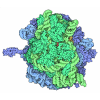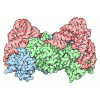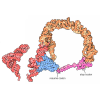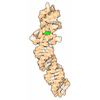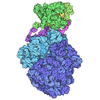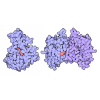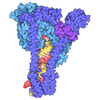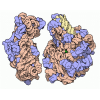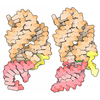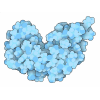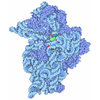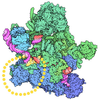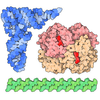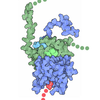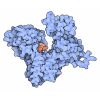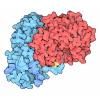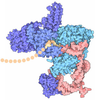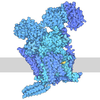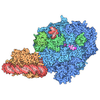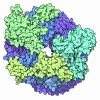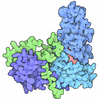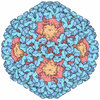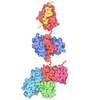+ Open data
Open data
- Basic information
Basic information
| Entry | Database: PDB / ID: 9c3i | ||||||||||||||||||||||||
|---|---|---|---|---|---|---|---|---|---|---|---|---|---|---|---|---|---|---|---|---|---|---|---|---|---|
| Title | Rebuilt CNOT3/tRNA-LEU structure | ||||||||||||||||||||||||
 Components Components |
| ||||||||||||||||||||||||
 Keywords Keywords | TRANSCRIPTION / mRNA degradation / CCR4-NOT complex / tRNA | ||||||||||||||||||||||||
| Function / homology |  Function and homology information Function and homology informationCCR4-NOT core complex / CCR4-NOT complex / regulation of stem cell population maintenance / nuclear-transcribed mRNA poly(A) tail shortening / trophectodermal cell differentiation / Deadenylation of mRNA / M-decay: degradation of maternal mRNAs by maternally stored factors / regulatory ncRNA-mediated gene silencing / TP53 regulates transcription of additional cell cycle genes whose exact role in the p53 pathway remain uncertain / P-body ...CCR4-NOT core complex / CCR4-NOT complex / regulation of stem cell population maintenance / nuclear-transcribed mRNA poly(A) tail shortening / trophectodermal cell differentiation / Deadenylation of mRNA / M-decay: degradation of maternal mRNAs by maternally stored factors / regulatory ncRNA-mediated gene silencing / TP53 regulates transcription of additional cell cycle genes whose exact role in the p53 pathway remain uncertain / P-body / regulation of translation / positive regulation of cold-induced thermogenesis / regulation of DNA-templated transcription / nucleus / cytosol Similarity search - Function | ||||||||||||||||||||||||
| Biological species |  Homo sapiens (human) Homo sapiens (human) | ||||||||||||||||||||||||
| Method | ELECTRON MICROSCOPY / single particle reconstruction / cryo EM / Resolution: 3.1 Å | ||||||||||||||||||||||||
 Authors Authors | Erzberger, J.P. / Cruz, V.E. | ||||||||||||||||||||||||
| Funding support |  United States, 7items United States, 7items
| ||||||||||||||||||||||||
 Citation Citation |  Journal: Science / Year: 2024 Journal: Science / Year: 2024Title: Specific tRNAs promote mRNA decay by recruiting the CCR4-NOT complex to translating ribosomes. Authors: Xiaoqiang Zhu / Victor Emmanuel Cruz / He Zhang / Jan P Erzberger / Joshua T Mendell /  Abstract: The CCR4-NOT complex is a major regulator of eukaryotic messenger RNA (mRNA) stability. Slow decoding during translation promotes association of CCR4-NOT with ribosomes, accelerating mRNA degradation. ...The CCR4-NOT complex is a major regulator of eukaryotic messenger RNA (mRNA) stability. Slow decoding during translation promotes association of CCR4-NOT with ribosomes, accelerating mRNA degradation. We applied selective ribosome profiling to further investigate the determinants of CCR4-NOT recruitment to ribosomes in mammalian cells. This revealed that specific arginine codons in the P-site are strong signals for ribosomal recruitment of human CNOT3, a CCR4-NOT subunit. Cryo-electron microscopy and transfer RNA (tRNA) mutagenesis demonstrated that the D-arms of select arginine tRNAs interact with CNOT3 and promote its recruitment whereas other tRNA D-arms sterically clash with CNOT3. These effects link codon content to mRNA stability. Thus, in addition to their canonical decoding function, tRNAs directly engage regulatory complexes during translation, a mechanism we term P-site tRNA-mediated mRNA decay. | ||||||||||||||||||||||||
| History |
| ||||||||||||||||||||||||
| Remark 0 | THIS ENTRY 9C3I REFLECTS AN ALTERNATIVE MODELING OF THE ORIGINAL DATA IN 8BHF, DETERMINED BY ...THIS ENTRY 9C3I REFLECTS AN ALTERNATIVE MODELING OF THE ORIGINAL DATA IN 8BHF, DETERMINED BY Absmeier, E., Chandrasekaran, V., O'Reilly, F.J., Stowell, J.A.W., Rappsilber, J., Passmore, L.A. |
- Structure visualization
Structure visualization
| Structure viewer | Molecule:  Molmil Molmil Jmol/JSmol Jmol/JSmol |
|---|
- Downloads & links
Downloads & links
- Download
Download
| PDBx/mmCIF format |  9c3i.cif.gz 9c3i.cif.gz | 121.9 KB | Display |  PDBx/mmCIF format PDBx/mmCIF format |
|---|---|---|---|---|
| PDB format |  pdb9c3i.ent.gz pdb9c3i.ent.gz | 74 KB | Display |  PDB format PDB format |
| PDBx/mmJSON format |  9c3i.json.gz 9c3i.json.gz | Tree view |  PDBx/mmJSON format PDBx/mmJSON format | |
| Others |  Other downloads Other downloads |
-Validation report
| Summary document |  9c3i_validation.pdf.gz 9c3i_validation.pdf.gz | 1.4 MB | Display |  wwPDB validaton report wwPDB validaton report |
|---|---|---|---|---|
| Full document |  9c3i_full_validation.pdf.gz 9c3i_full_validation.pdf.gz | 1.4 MB | Display | |
| Data in XML |  9c3i_validation.xml.gz 9c3i_validation.xml.gz | 34.5 KB | Display | |
| Data in CIF |  9c3i_validation.cif.gz 9c3i_validation.cif.gz | 48.2 KB | Display | |
| Arichive directory |  https://data.pdbj.org/pub/pdb/validation_reports/c3/9c3i https://data.pdbj.org/pub/pdb/validation_reports/c3/9c3i ftp://data.pdbj.org/pub/pdb/validation_reports/c3/9c3i ftp://data.pdbj.org/pub/pdb/validation_reports/c3/9c3i | HTTPS FTP |
-Related structure data
| Related structure data |  9c3hC C: citing same article ( M: map data used to model this data |
|---|---|
| Similar structure data | Similarity search - Function & homology  F&H Search F&H Search |
- Links
Links
- Assembly
Assembly
| Deposited unit | 
|
|---|---|
| 1 |
|
- Components
Components
| #1: Protein | Mass: 64125.828 Da / Num. of mol.: 1 Source method: isolated from a genetically manipulated source Source: (gene. exp.)  Homo sapiens (human) / Gene: CNOT3, KIAA0691, LENG2, NOT3 / Production host: Homo sapiens (human) / Gene: CNOT3, KIAA0691, LENG2, NOT3 / Production host:  |
|---|---|
| #2: RNA chain | Mass: 27730.480 Da / Num. of mol.: 1 / Source method: isolated from a natural source / Source: (natural)  |
| Has ligand of interest | N |
| Has protein modification | N |
-Experimental details
-Experiment
| Experiment | Method: ELECTRON MICROSCOPY |
|---|---|
| EM experiment | Aggregation state: PARTICLE / 3D reconstruction method: single particle reconstruction |
- Sample preparation
Sample preparation
| Component | Name: CNOT3/tRNA-Leu / Type: COMPLEX / Entity ID: all / Source: MULTIPLE SOURCES |
|---|---|
| Source (natural) | Organism:  |
| Buffer solution | pH: 7.5 |
| Specimen | Embedding applied: NO / Shadowing applied: NO / Staining applied: NO / Vitrification applied: YES |
| Vitrification | Cryogen name: ETHANE |
- Electron microscopy imaging
Electron microscopy imaging
| Experimental equipment |  Model: Titan Krios / Image courtesy: FEI Company |
|---|---|
| Microscopy | Model: FEI TITAN KRIOS |
| Electron gun | Electron source:  FIELD EMISSION GUN / Accelerating voltage: 300 kV / Illumination mode: FLOOD BEAM FIELD EMISSION GUN / Accelerating voltage: 300 kV / Illumination mode: FLOOD BEAM |
| Electron lens | Mode: BRIGHT FIELD / Nominal defocus max: 1200 nm / Nominal defocus min: 600 nm |
| Image recording | Electron dose: 30 e/Å2 / Film or detector model: FEI FALCON IV (4k x 4k) |
- Processing
Processing
| CTF correction | Type: NONE |
|---|---|
| 3D reconstruction | Resolution: 3.1 Å / Resolution method: FSC 0.143 CUT-OFF / Num. of particles: 100000 / Symmetry type: POINT |
 Movie
Movie Controller
Controller






 PDBj
PDBj